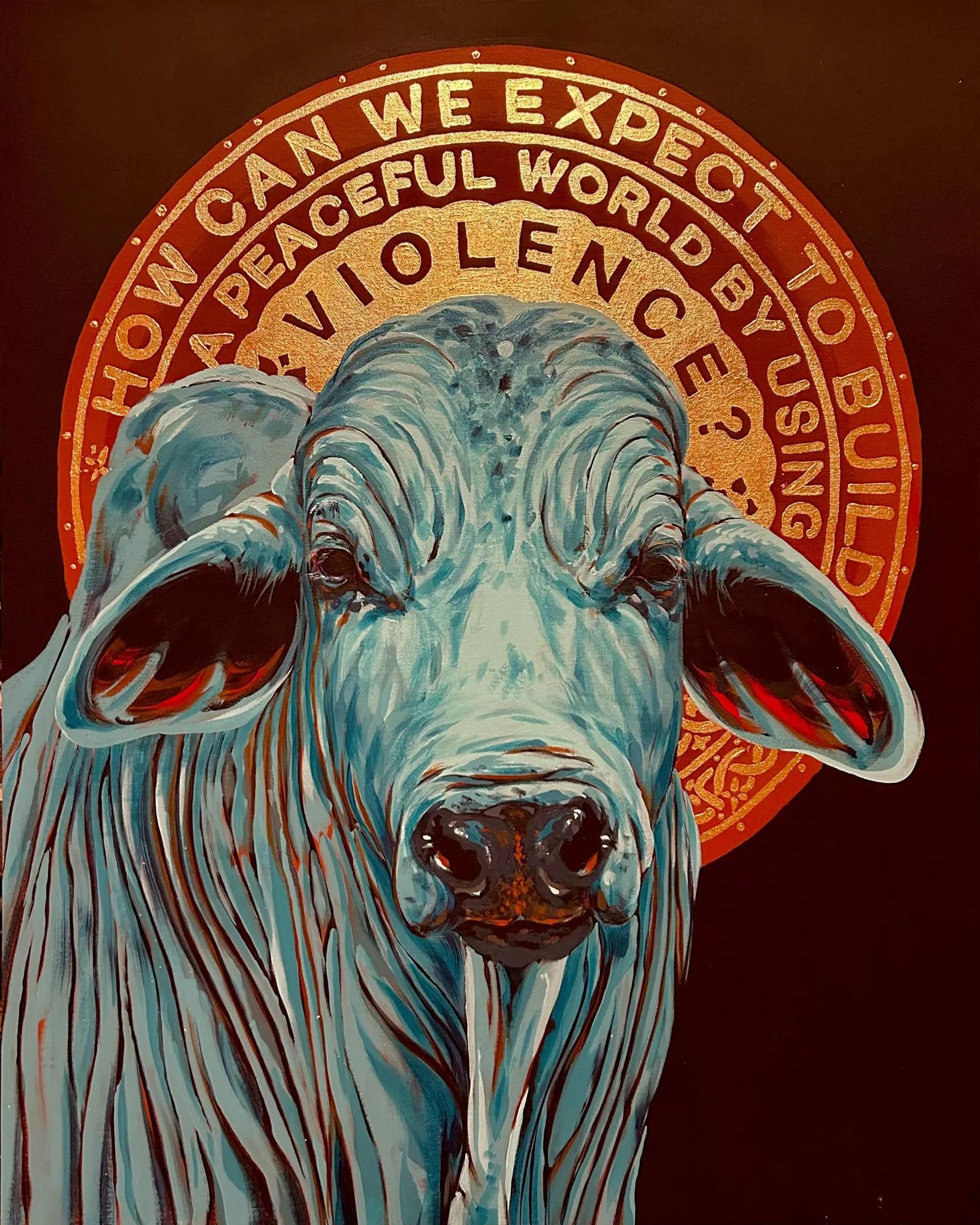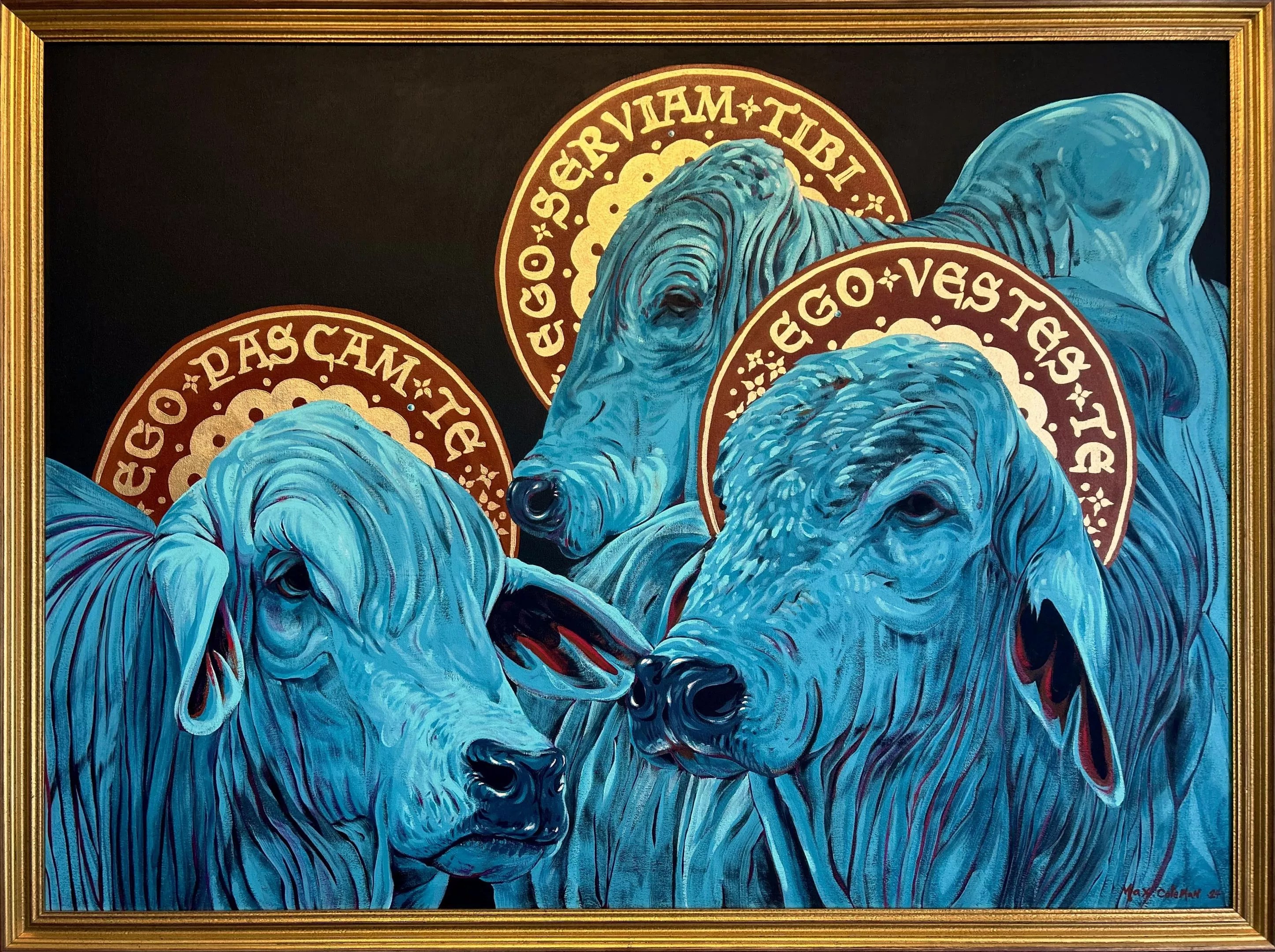
Max Coleman

Audio By Carbonatix
Take a walk through almost any neighborhood of Denver and you will likely find the street art of Max Coleman on walls big and small. His bold, bright and engaging work is centered around awareness and advocacy for animals and the environment, and he has been an active part of the street-art community in Denver for many years. Now Coleman is focusing on his background in fine art and has created a series of captivating paintings titled The Burden of Cattle. This new body of work will debut at the Banshee House, an experimental creative venue in the heart of RiNo, on Friday, March 15, with an opening show at 6 p.m.
The Burden of Cattle is in many ways a culmination of Coleman’s artistic journey thus far, the beginnings of which trace back to his childhood. Splitting his time between the New England coastline and the Rocky Mountains, his communion with the natural world is deeply rooted in experience as well as teachings from his parents; his mom, a geologist in Colorado, and his dad, a poet in Connecticut, both gave him a unique and meaningful lens through which to view the world.
“I was definitely taught from a young age that the natural world was way more legitimate than anything that was made by people,” Coleman says. “I grew up with a notion that animals were just as important as us. That was really central, and that has continued into my work, and certainly into this show.”

“How can we expect to build a peaceful world by using violence?” she asks you.
Max Coleman
Coleman’s passion for drawing began at an early age. “I would draw mostly slimy fish and sea creatures that I would invent,” he recalls. “We were always around the ocean, and so I would usually take home dead things that I would find from the beach and I would draw things inspired by that.”
This fascination with life forms is what eventually led him to apply to the Rhode Island School of Design (RISD), where he fell in love with the prestigious art school’s Nature Lab, a collection of plants, animals and other living things kept in a preserved state. When he saw students checking out skeletons, assortments of seeds and jars of animals in formaldehyde as if they were library books, he knew it was the art school for him.
Studying at RISD was immensely gratifying and affirming for Coleman. “It was like a moment of suddenly speaking the same language with everybody you were around, after a long time of not,” he says. There he made lifelong friendships with fellow creatives who are all still practicing artists to this day, and it was during his senior year that the conceptual framework of his forthcoming artwork truly came into focus.
“I’ve always been really fascinated with life in all of its forms,” he shares, “The fact that life, we think, came from the oceans 3.5 billion years ago, and that it occurred because the sun was blasting the Earth with ultraviolet radiation and light for a very long time…and somehow, life organized itself. And since then the sun has just been sort of this stick prodding it, and it went from simple cells to algae to fish to things going onto the land and now to us. I thought, ‘Wow, the sun is a really generous star!’ And that clicked something in me.
“From then on, I have been fascinated with depictions that initiate feelings of gratitude in the viewer. Either expressing gratitude by looking at the beauty of this stage we live on, the Earth, or expressing gratitude by showing hardships that benefit people today,” he continues, “So, I looked at the lens of the sun as both initiating life and initiating death, and I thought, ‘I want to make a body of work that explores that theme of selfless but non-intentional giving to create life, and then the morals, interspecies conflicts and geologic conflicts that arise from that.'”

“The Fates,” by Max Coleman.
The Banshee House
After graduating from RISD, Coleman took this creative energy to the streets of Boston for a year, where he began making street art. But soon he found himself returning to the place where he’d spent his summers as a kid: Colorado. “There’s an undeniable draw to the Rockies – the Front Range, in particular. I just have always felt that there’s possibility out here,” he says. “I was reading articles in Westword and in the Denver Post and seeing all the things that were happening in the street-art world out here, and I wanted to be a part of it.”
Coleman moved to Denver in 2017 and immediately began forging his path as an artist. “I started making little books and self-published zines and wheat paste drawings and painting any free wall that anyone would give me,” he remembers. He was right in the midst of the burgeoning mural scene in the city, and he wasted no time contributing to the collective movement under the moniker Oak Bloak.
“I think street art should initiate conversation and discomfort more than it should decorate,” he says.
As his body of work grew, so did this principle. A significant milestone came during the 2019 Crush Walls festival, when he painted a mural on the side of Crema Coffee House. It depicted a blue buffalo paired with text from a Dylan Thomas poem – “Rage against the dying of the light” – and this link between poetry and animal portraiture created another spark.
“I remember being very excited about the stories that I could tell with animals, and I think from there I’ve continued to tell stories with animals,” he says. “I think they’re a way more efficient way to tell a narrative, because people don’t assign any predisposition to them. I feel like when you see a person, you know too much about people, so you can assume things. Whereas if an animal presents something to you, they are neutral and only acting upon the ebbs and flows of the natural order of the earth.”

Coleman’s mural for Crush Walls 2019.
Courtesy of the artist’s website
This notion is just one of the facets that makes Coleman’s current body of work so powerful. While his work up until now has been largely graphic and “whimsical,” he says, his recent foray into more “academic” painting has marked a crucial shift. “With The Burden of Cattle, I’ve really discovered, I feel, the depth and the sort of sinewy life blood underneath the skin of what I’ve been painting for the first time, which is really exciting,” he reflects.
As part of this shift, Coleman has found himself largely influenced by the Baroque period, finding inspiration from such artists as Caravaggio, Peter Paul Rubens and Francisco Goya. In particular, Goya’s Disasters of War has become the framework for a larger project in which Coleman seeks to re-create the series of 45 prints, which encompass “some of the most shocking and honest depictions of war that you’ll ever see” – but with cows, telling their plight in the various industries and supply chains of the world.
Coleman’s upcoming solo show is an extension of this body of work, and “an important stepping stone in telling this small facet of one animal’s story and their contribution to humanity,” he says. But while the messaging may be exigent, this show will offer a truly unique type of gallery experience that is both immersive and heartfelt.
At The Burden of Cattle, guests can look forward to Flemish-Renaissance music, candlelight, ornate golden Baroque frames and “a herd of twelve saintly bovines,” Coleman says. “Some of them have gilded halos behind them, some of them are resting on satin beds, some of them are engaged in covert meetings at night talking to one another. It’s definitely something that will be memorable and strange, but compelling.
“I think it accomplishes the core of the project by just trying to spread compassion. It’s an exercise in gratitude; I’m very pleased that it at least makes me feel that way, and I’m excited to open my work up to a public viewing,” Coleman concludes. “I hope that [audiences] can find new things beautiful that they didn’t see before. … That’s the most exciting thing, because the world is full of so many beautiful things to appreciate.”
The Burden of Cattle, 6 p.m. Friday, March 15, the Banshee House, 2715 Larimer Street. Admission is free. Food and drinks will be provided.